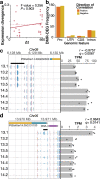A genome assembly and the somatic genetic and epigenetic mutation rate in a wild long-lived perennial Populus trichocarpa
- PMID: 33023654
- PMCID: PMC7539514
- DOI: 10.1186/s13059-020-02162-5
A genome assembly and the somatic genetic and epigenetic mutation rate in a wild long-lived perennial Populus trichocarpa
Abstract
Background: Plants can transmit somatic mutations and epimutations to offspring, which in turn can affect fitness. Knowledge of the rate at which these variations arise is necessary to understand how plant development contributes to local adaption in an ecoevolutionary context, particularly in long-lived perennials.
Results: Here, we generate a new high-quality reference genome from the oldest branch of a wild Populus trichocarpa tree with two dominant stems which have been evolving independently for 330 years. By sampling multiple, age-estimated branches of this tree, we use a multi-omics approach to quantify age-related somatic changes at the genetic, epigenetic, and transcriptional level. We show that the per-year somatic mutation and epimutation rates are lower than in annuals and that transcriptional variation is mainly independent of age divergence and cytosine methylation. Furthermore, a detailed analysis of the somatic epimutation spectrum indicates that transgenerationally heritable epimutations originate mainly from DNA methylation maintenance errors during mitotic rather than during meiotic cell divisions.
Conclusion: Taken together, our study provides unprecedented insights into the origin of nucleotide and functional variation in a long-lived perennial plant.
Keywords: DNA methylation; Epigenetics; Epimutation rate; Mutation rate; Poplar.
Conflict of interest statement
The authors declare that they have no competing interests.
Figures





References
-
- Walbot V. On the life strategies of plants and animals. Trends Genet. 1985; 10.1016/0168-9525(85)90071-X.
-
- Gill DE. Individual plants as genetic mosaics: ecological organisms versus evolutionary individuals. In: Crawley MJ, editor. Plant Ecol. Oxford: Blackwell Scientific Publications; 1986. pp. 321–343.
-
- Gill DE, Chao L, Perkins SL, Wolf JB. Genetic mosaicism in plants and clonal animals. Annu Rev Ecol Syst. 1995;26:423–444. doi: 10.1146/annurev.es.26.110195.002231. - DOI
-
- Hadany L. A conflict between two evolutionary levels in trees. J Theor Biol. 2001; 10.1006/jtbi.2000.2236. - PubMed
Publication types
MeSH terms
Grants and funding
LinkOut - more resources
Full Text Sources
Molecular Biology Databases

